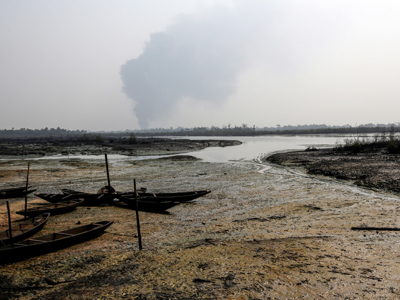
Hydropower, racism and the denial of justice
For Black History Month, trainee solicitor Walker Syachalinga discusses the history of the Tonga - an indigenous tribe in Zambia - to highlight the racism suffered by indigenous communities during large dam projects and call for a rights-based approach to such projects.
Posted on 11 October 2021
The declaration of a climate emergency has resulted in a surge of hydropower projects. This requires the construction of dams, a process that often pits indigenous communities against large multinational companies.
A 2012 survey found that more than 70% of people who had been resettled to make way for the construction of a dam had become impoverished, with pervasive and institutional racism and discrimination partly to blame for indigenous communities and ethnic minorities suffering disproportionately from the negative impacts of large dams.
Racial injustice at Kariba Dam
Between 1956 and 1960, Britain’s colonial government and the World Bank facilitated the construction of the Kariba Dam on the Zambezi river in Zambia and Zimbabwe. To succeed the project would require 25,000 indigenous Zambian Tonga to be displaced along with their livestock and possessions, leaving behind their religious shrines and burial sites. Predicting the racial injustice to come, John Rankin MP presciently warned the House of Commons in 1956 of the need to “establish the precedent, similar to that which is accepted among the white races”for equality of treatment and fair compensation of the Tonga.
Eight Tonga tribesmen were shot and killed and 32 injured by colonial forces while protesting their forced displacement. For those who agreed to be resettled without resistance only £10 was given as total compensation for the loss of huts, developed land and crop production. Once Tonga villages had been flooded to create the Kariba Dam, white settlers applied to own exclusive plots of land on the newly created lakeshore with some of the most valuable land given to an expatriate “who used paramilitary troops to drive the resident population of Tonga fishers and farmers from the area, causing the death of at least one”.
Women lost their land without compensation during displacement as the British colonial authorities that built the Kariba Dam only recognised men as land owners. 41 children died of chicken pox and measles in January 1959 while a further 37 women and children died in September of the same year after consuming vegetable poison following food shortages in resettlement camps. The following year, 56 women and children died including approximately 10 percent in one village.
To this day, many of the forcibly displaced Tonga are still unconnected to the national grid lines as electricity generated by the dam is largely channelled to the “copper companies for which much of the power was destined”. Drought and food insecurity remain a regular occurrence.
Hydropower and the climate emergency
The climate emergency and the drive for hydropower has brought the racial injustice suffered by indigenous communities into sharp focus. In echoes of the plight of the Tonga, nine members of an indigenous community opposed to dam projects in the Philippines were killed in December 2020. In the Democratic Republic of Congo, the Grand Inga Dam which is planned for the Congo river would displace tens of thousands of people while the construction of the Grand Ethiopian Renaissance Dam in Ethiopia has raised concerns about compensation and land rights of the local Gumuz communities who are due to be resettled. In the Amazon, 158 dams are either operating or under construction and a further 351 are proposed, posing a threat to the many indigenous communities reliant on it.
These and other concerns have led international charities such as Oxfam to call for a reappraisal of hydropower projects as the solution to addressing the climate emergency. The charities note that dams have displaced at least 40-80 million people and have negatively affected an estimated 472 million people living downstream. Generally, even the green energy credentials of dams have been questioned by the revelation that dams emit a billion tonnes of greenhouse gases a year while their reliability as a source of electricity remains doubtful due to the increased risk of disruption to electricity supply caused by poor rainfall.
Way forward for hydropower – more needs to be done
On 24 September 2021, the San Jose Declaration on Sustainable Hydropower was handed to COP26 President Alok Sharma to deliver to the UN Climate Change Conference in Glasgow in November. The Declaration states that “All project-affected communities, including Indigenous Peoples and vulnerable groups, should be identified and engaged in the issues of interest to them, and livelihoods and living standards impacted by the project should be improved relative to pre-project conditions”. However, the Declaration is silent on the racism routinely suffered by communities during dam projects. Nor does the Declaration create a legally enforceable right that communities should share in benefits emanating from new dams or a right of legal and other redress for adversely affected communities. Equally, there is no mention of any sanctions for corporate entities that fund and profit from large dam projects with adverse impacts on local indigenous communities.
With most large dam projects raising issues of corporate and state accountability, the Declaration also misses the opportunity to address access to justice challenges faced by communities such as those which Leigh Day routinely acts for. Whilst legal redress and compensation is available in some countries, the process and ability to access justice varies widely, with the rights of individuals and particular communities pitted against the wider perceived benefits of large scale infrastructure projects.
By comparison, where people have been compelled to move to make way for large scale infrastructure projects such as HS2 in the UK, provision has been made for compensation at full market value. The UK’s Presidency of COP26 should therefore highlight equal rights to legal redress for vulnerable indigenous communities in remote parts of the world affected by large hydropower projects.
The history of the Tonga is just one snapshot of the racial injustice that results from a failure to heed warnings to afford local indigenous communities’ equal treatment, fair compensation and access to justice. Such injustices will only be exacerbated by a blind pursuit of hydropower under the pretext of the climate emergency and in the end make communities already reeling from the effects of climate change even more destitute. The UK’s presidency of COP26 is an opportunity to reshape hydropower projects in favour of communities disproportionately affected by them. Such reshaping should necessarily include improving access to justice for adversely affected communities.



